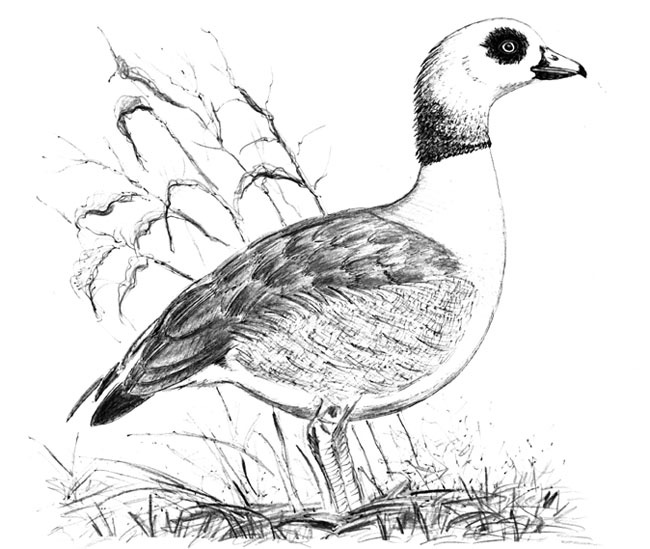
Dear Bird Folks,
I saw this bird on a Falmouth beach last week and took the attached photo with my iPhone. What is it?
– George, Falmouth, MA
I know what it is, George,
The first time I saw one of those birds I was birding in southern Florida with my son, Casey. Many birding locations in Florida are dark, swampy wilderness areas, but not this place. We were in the Wakodahatchee Wetlands, which is a tiny preserved plunk in the middle of the congested and fashionable town of Delray Beach. Birding there is like bird watching in the courtyard of a high-end shopping mall. Yet, the area somehow attracts a huge variety of birds. We saw herons, grebes, rails and even spoonbills. After about an hour of walking the trails, Casey called me over and asked, “What are those birds?” Sitting on the grass, along the side of a canal, were three of the weirdest birds I had ever seen. They were some kind of waterfowl, but they were too big to be ducks and too small to be geese. They had red legs and colorful bodies, but the most distinctive feature was their eyes. Around each one of their eerie yellow eyes was a creepy rusty patch of feathers. They looked like a trio of avian zombies that had just escaped from the set of The Walking Dead.
Casey looked at me as if to say, “Come on, old man; this is what they pay you for. What are they?” I had no clue. So, I did exactly what you did, George, I took out my iPhone and snapped a photo. I had decided that the mystery birds couldn’t possibly be from North America. They were most likely exotics that had escaped from a nearby park. I immediately sent the photo to Matt, our staff duck guy. He raises all sorts of domesticated ducks and actually attends poultry shows. (Go figure.) If anyone would know what we were looking at, Matt would. And he did. In an amazing display of instantaneous, high tech birding, we were still standing along the wetlands, still staring at the birds and still scratching our heads, when we received a text message back from Matt. He confirmed that our mystery birds were Egyptian Geese. He said they are native to Africa, sometimes seen in Florida and now, apparently, Falmouth. I thought: it’s about time something moved from Florida to Falmouth, instead of vice versa.
As you might have guessed from their name, Egyptian Geese are native to the Nile River Valley of North Africa. However, these birds aren’t really geese and may not even be ducks. Egyptian Geese are closely related to shelducks and have been placed in a group of birds known as Tadorninae, which is a sub-family of waterfowl that has confused scientists for years. (You probably didn’t need to know any of that, George, but I felt I needed to add some serious information about the birds…other then that they look like zombies.) The ancient Egyptians didn’t care what they were either; they just liked them. It is thought that the early Egyptians were the first ones to domesticate these birds and even considered them to be sacred. (Of course, Ancient Egyptians also thought cats were sacred. So what did they know?)
This is an important time for waterfowl. This is when millions of them take to the air for their annual fall migration. But Egyptian Geese don’t bother with all of that flocking, honking and quacking. They tend to be more sedentary, unless a lack of food forces them to look elsewhere. Egyptian Geese are typically found near water, but they don’t really like water all that much. Even though they are good swimmers and can even dive, they prefer to be on land. They are normally seen walking through fields of short vegetation and feeding on grass…like sheep. And instead of spending the night in the safety of ponds, lakes or rivers, Egyptian Geese sleep in trees…like monkeys. These geese are truly odd ducks.
The next question is: If Egyptian Geese don’t like to migrate, how were they able go from Africa to Florida and eventually to every bird’s dream destination, Falmouth? The answer is FedEX, or some equivalent. It turns out that many people actually think these birds are attractive and willingly import them for ornamental purposes. Several European countries, including England, have introduced Egyptian Geese to their parks and estates. It also appears that Florida’s big fancy country clubs have done the same, and I don’t get it. I usually can find beauty in any bird, but Egyptian Geese creep me out. I just can’t get past the gross patches around their eyes. To me, they look like stoners with conjunctivitis and who needs more of that walking around town?
Attractive or not, usually any imported species causes problems. Those stately Mute Swans we all love so much are really an environmental nightmare. The eating habits of the giant white birds is slowly damaging important ecosystems. But at this point, Egyptian Geese aren’t a problem. They seem to get along with our native waterfowl and their feeding and sleeping habits don’t bother anybody…except for maybe sheep and monkeys.
I have no idea how that Egyptian Goose you photographed ended up in Falmouth, George. Perhaps it escaped from a duck pen in one of your neighbor’s backyards. But don’t be afraid of it. Unlike Mute Swans, Egyptian Geese don’t seem to be hostile towards people…despite their zombie look.